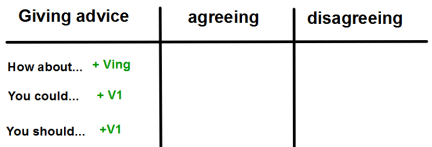A newly-qualified CELTA teacher has asked me for advice about how to deal with functional language. So… this is one of my approaches to teaching functional language! The example is from a lesson I did last weekend about the World Cup. The target language was phrases for making suggestions/giving advice, along with agreeing and disagreeing with the advice.
Disclaimer: This type of thing works for me. If you’re fresh off the CELTA and looking for a route into dealing with functional language then it might be worth trying, but I am speaking only from experience, not from authority…
Step 1: Find out what language the learners already know…
After a general World Cup chat, do a short roleplay task…
Post-task feedback, board any target language that learners already use…
Step 2: Task model
Students listen to a real example of the convo they just tried. I say ‘real’ – it’s normally a recording I’ve made with another teacher! We try not to grade things too much or make things too contrived, but you know how these things can go in practice…
Do a few gist/detail comprehension tasks. Stuff like: Did they offer the same advice as you? Did they give good advice? Maybe some True/False questions….
(extract from the listening I did)
Step 3: Focus on target language
Students identify target phrases used in the text (listening, maybe reading the transcript after if they don’t pick up on them). They make a table in their books to record this all nicely (or just give a handout if you’re nice!!! My teens love making their own neat tables for some reason!). Bit of form focus.
(I don’t board all the answers, like to elicit them…).
Students add any other useful phrases they know to their table. I feedback on this to check they’re relevant…
Bit of pronunciation work here too. Drill appropriate intonation, etc
Step 4: practice
I often repeat the task in Step 1 here. Maybe learners start off by reading the transcript together, but mainly I want them to repeat the Step 1 task using the target phrases
Step 5: more practice
More practice – give learners prompt ‘problem’ cards. They have their own problem/advice convos trying to integrate the target language. You can keep the prompts simple, let the learners build the dialogue themselves. I didn’t stick with football for this bit – I veered off to things like ‘I smashed my mate’s favourite cup’, ‘I need help with XYZ’ etc… Correct/upgrade if necessary
Step 6: even more practice
Same as above but more personalised – students could ask for advice re: a current problem they have. Repeat task, lots of practice. Include some kind of ‘reason to listen’ task, like ‘Who gave you the best advice?’. From the CELTA you might remember: feedback on content, feedback on language…
Why this approach?
- I find it relatively straightforward to plan – as long as a teacher agrees to help with the recording. There’s always live listening otherwise… hmmm actually I don’t do that much
- I can include exactly what I want in the listening text. I can also make it sound a bit more authentic, as sometimes the coursebook listening can be a bit… meh
- Easy to personalise
- Easy to work out what students already know
- Students are doing the task straight away and throughout lesson. This helps with establishing a sense of progress
Things I’ve learnt when using this technique
It’s useful to see what students already know re: target language. It can also be a spanner in the works for your planning! (Tut, those pesky learners already knowing things!) It’s good to be ready to upgrade language. I write down additional phrases I can input if learners are familiar with the target language already.
How do I upgrade?
I make notes while learners complete the task. I give delayed feedback after each attempt at the task, where I use extracts from learner convos as examples and input some alternative language they could use. I have other approaches too, depending on time. One is to exploit the listening model more.
I sometimes create two versions of the listening. I give learners the original transcript – I play the alternative listening and instruct them to mark any differences. For example, in the extract where Emma says ‘you could watch….’ I might replace this with ‘It might be worth watching…’ or something like that. If I don’t have time for two recordings, sometimes I dictate these alternatives to learners…
You could watch the highlights
It might be worth watching the highlights
Why don’t you (just) watch the highlights?
Etc
A word on recording your own listening texts…
I should point out that I don’t record my own listening every time I teach functional language!!! When I first started teaching I found it quite hard to create my own texts, but I’ve got a lot better (and quicker) at it. I think the trick is not to be a perfectionist! I encourage you to give it a go – it’s easier than you think, although it is sometimes cringeworthy to hear the sound of your own voice…
Let me know if you try something like this. I can share examples of the recordings I make if it helps.
Categories: grammar, teacher development




Some nice ideas Pete. I love the idea of demonstrating key language after the role-play as a way to review and complement. Gives a nice structure to lessons. Definitely sharing this with my YL teachers.
LikeLike
Simple, straightforward, and very useful. Thanks a lot.
LikeLiked by 2 people